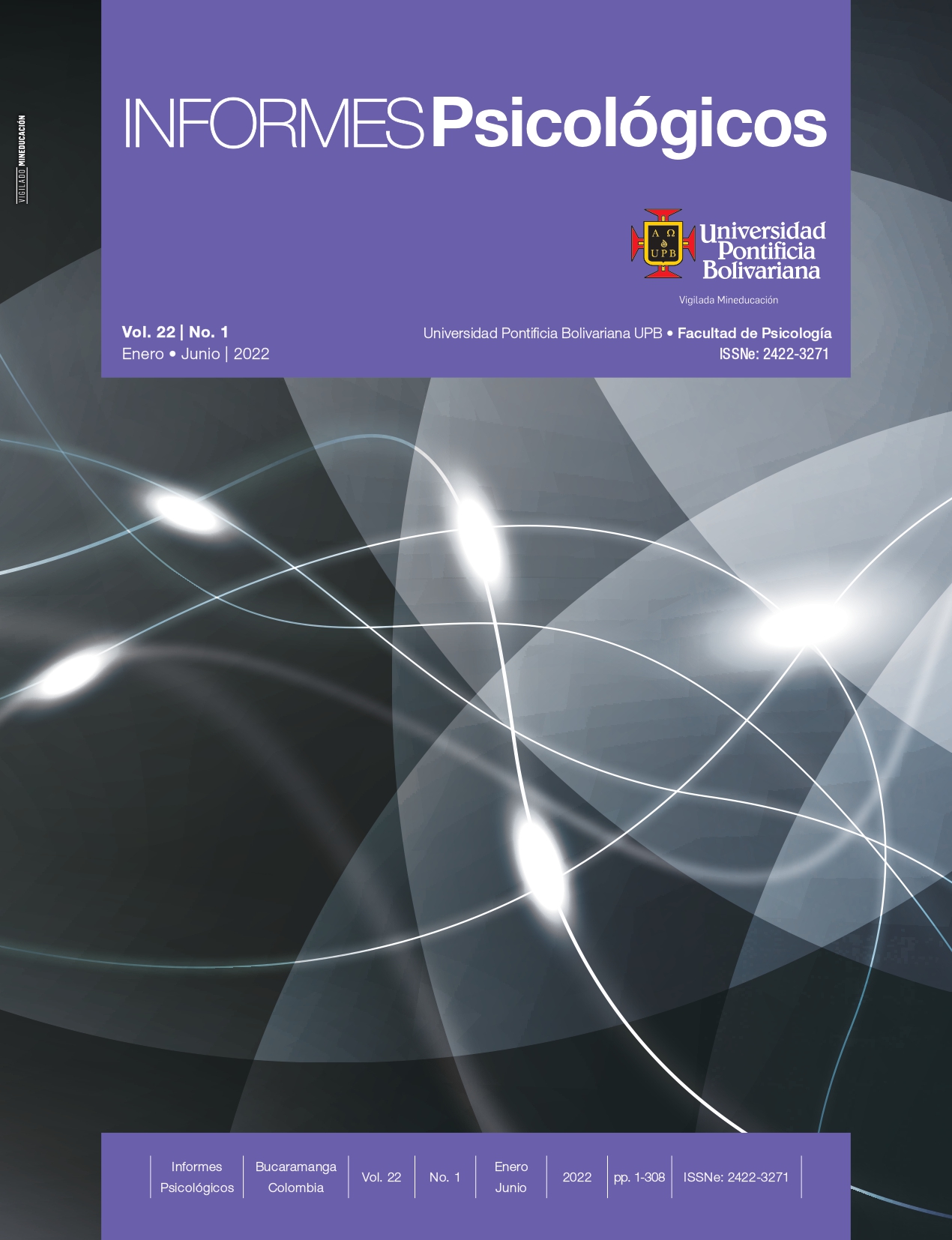Identidad social: conductas sanitarias y solidarias en México ante el confinamiento por COVID-19
Contenido principal del artículo
Resumen
En concordancia con la teorización y hallazgos empíricos del Modelo Elaborado de la Identidad Social, se adaptó una escala para evaluar las conductas solidarias durante la emergencia derivada de la enfermedad COVID-19. 600 mujeres y 400 hombres respondieron la batería en redes sociales y otros contactos digitales. Los resultados del Análisis Factorial Confirmatorio mostraron un ajuste adecuado del instrumento χ2(247) = 732.53 p < .001, CFI = .96; RMSEA = .045; SRMR = .049. Un segundo modelo, que incluyó la exposición a la emergencia sanitaria, probó diversas hipótesis relacionadas con la predicción de la ejecución de conductas solidarias, los resultados mostraron un ajuste adecuado χ2(247) = 732.53 p < .001, CFI = .96; RMSEA = .045; SRMR = .045. La identidad social, derivada de un destino común ante la emergencia, y la observación de conductas solidarias predicen el seguimiento de normas sanitarias, brindar apoyo socioemocional y coordinado en redes.
Referencias
Allington, D., Duffy, B., Wessely, S., Dhavan, N., & Rubin, J. (2020). Health-protective behaviour, social media usage, and conspiracy belief during the COVID-19 public health emergency. Psychological Medicine. https://doi.org/10.1017/S003329172000224X
Bandura, A. (1982). Teoría del Aprendizaje Social. Madrid: Espasa Calpe.
Brooks, S. K., Webster, R. K., Smith, L. E., Woodland, L., Wessely, S., Greenberg, N., & Rubin, G. J. (2020). The psychological impact of quarantine and how to reduce it: rapid review of the evidence. The Lancet, 395(10227), 912–920. https://doi.org/10.1016/S0140-6736(20)30460-8
Buechler, S. M. (1993). Beyond resource mobilization? Emerging Trends in Social Movement Theory. Sociological Quarterly, 34(2), 217–235. https://doi.org/10.1111/j.1533-8525.1993.tb00388.x
Cocking, C., Drury, J., & Reicher, S. (2009). The psychology of crowd behaviour in emergency evacuations: Results from two interview studies and implications for the Fire and Rescue Services. Irish Journal of Psychology, 30(1–2), 59–73. https://doi.org/10.1080/03033910.2009.10446298
Drury, J. (2018). The role of social identity processes in mass emergency behaviour: An integrative review. European Review of Social Psychology, 29(1), 38–81. https://doi.org/10.1080/10463283.2018.1471948
Drury, J. (2020). Recent developments in the psychology of crowds and collective behaviour. Current Opinion in Psychology, 35, 12–16. https://doi.org/10.1016/j.copsyc.2020.02.005
Drury, J., Brown, R., González, R., & Miranda, D. (2016). Emergent social identity and observing social support predict social support provided by survivors in a disaster: Solidarity in the 2010 Chile earthquake. European Journal of Social Psychology, 46(2), 209–223. https://doi.org/10.1002/ejsp.2146
Drury, J., Cocking, C., & Reicher, S. (2009a). Everyone for themselves? A comparative study of crowd solidarity among emergency survivors. British Journal of Social Psychology, 48(3), 487–506. https://doi.org/10.1348/014466608X357893
Drury, J., Cocking, C., & Reicher, S. (2009b). The Nature of Collective Resilience: Survivor Reactions to the 2005 London Bombings. International Journal of Mass Emergencies and Disasters, 27(1), 66–95.
Drury, J., & Reicher, S. (1999). The Intergroup Dynamics of Collective Empowerment: Substantiating the Social Identity Model of Crowd Behavior. Group Processes and Intergroup Relations, 2(4), 381–402. https://doi.org/10.1177/1368430299024005
Fantasia, R. (1989). Cultures of Solidarity: Consciousness, Action, and Contemporary American Workers. Rick Fantasia. London England, University of California Press, Ltd. https://doi.org/10.1086/229211
Featherstone, M. (1995). Undoing culture: globalization, postmodernism and identity (S. Publications, Ed.). London, Thousand Oaks,.
Fernández-Poncela, A. M. (2012). Psicología de masas, identidad social, epidemias y rumores: la influenza en...: Discovery Service para Universidad Peruana Unión. Sociológica, 27(76), 189–230. Retrieved from http://eds.a.ebscohost.com/eds/pdfviewer/pdfviewer?vid=0&sid=75ad6a4c-b588-4b0e-bb35-c87ffb0c2e85%40sessionmgr4006
Hu, L. T., & Bentler, P. M. (1999). Cutoff criteria for fit indexes in covariance structure analysis: Conventional criteria versus new alternatives. Structural Equation Modeling, 6(1), 1–55. https://doi.org/10.1080/10705519909540118
Mawson, A. R. (2005). Understanding mass panic and other collective responses to threat and disaster. Psychiatry, 68(2), 95–113. https://doi.org/10.1521/psyc.2005.68.2.95
Melucci, A. (1989). Nomads of the Present: Social Movements and Individual Needs in Contemporary Society (H. Radius, Ed.). London.
Pérez-Escoda, A., Jiménez-Narros, C., Perlado-Lamo-de-espinosa, M., & Pedrero-Esteban, L. M. (2020). Social networks’ engagement during the COVID-19 pandemic in Spain: Health media vs. healthcare professionals. International Journal of Environmental Research and Public Health, 17(14), 1–17. https://doi.org/10.3390/ijerph17145261
Redacción. (2020). Infodemia masiva invade sociedades de México y el mundo. Retrieved from 08/08/2020 website: https://www.eleconomista.com.mx/arteseideas/Infodemia-masiva-invade-sociedades-de-Mexico-y-el-mundo-20200805-0064.html
Reicher, S. (2008). The Psychology of Crowd Dynamics. In M. A. Hogg & R. S. Tintale (Eds.), Blackwell Handbook of Social Psychology: Group Processes (pp. 182–208). Oxford: Oxford: Blackwell. https://doi.org/10.1002/9780470998458.ch8
Sandín, B., Valiente, R. M., García-Escalera, J., & Chorot, P. (2020). Impacto psicológico de la pandemia de COVID-19: Efectos negativos y positivos en población española asociados al periodo de confinamiento nacional. Revista de Psicopatología y Psicología Clínica, 25(1), 1. https://doi.org/10.5944/rppc.27569
Solnit, R. (2009). A paradise built in hell: The extraordinary communities that arise in disaster. (Viking). New York.
Sudbury, J. (2012). Ethnic and Racial Studies ( Re ) constructing multiracial blackness : women ` s activism , difference and collective identity in Britain. Ethnic and Racial Studies, 24(1), 29–49. https://doi.org/10.1080/0141987002000653
Turner, J. C., Oakes, P. J., Haslam, S. A., & McGarty, C. (1994). Self and Collective: Cognition and Social Context. Personality and Social Psychology Bulletin, 20(5), 454–463. https://doi.org/10.1177/0146167294205002
Uluğ, Ö. M., & Acar, Y. G. (2019). ‘Names will never hurt us’: A qualitative exploration of çapulcu identity through the eyes of Gezi Park protesters. British Journal of Social Psychology, 58(3), 714–729. https://doi.org/10.1111/bjso.12305
UNAM. (2020). Riesgos y vulnerabilidades por COVID-19 reestructuran al mundo. Retrieved from https://www.dgcs.unam.mx/boletin/bdboletin/2020_698.html?fbclid=IwAR20DBCaMKnlBhimcYfBKfug4PFZlQNMAQ6PxhEoC3bKDRq8XZGshOEIois
Zandifar, A., & Badrfam, R. (2020). Iranian mental health during the COVID-19 epidemic. Asian Journal of Psychiatry, 51(February), 101990. https://doi.org/10.1016/j.ajp.2020.101990
Zeitz, K. M., Tan, H. M., Grief, M., Couns, P. C., & Zeitz, C. J. (2009). Crowd behavior at mass gatherings: A literature review. Prehospital and Disaster Medicine, 24(1), 32–38. https://doi.org/10.1017/S1049023X00006518


